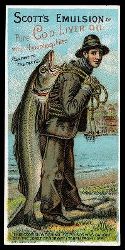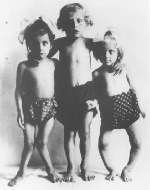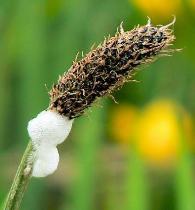Cures
Children who survived the rigours of childbirth had then to face childhood illnesses – without the medical services and antibiotics that are available to us today. Scalds were treated with the first snow of the year. The snow water was melted and kept. Burns were treated with bread soda or linseed oil, or country butter and egg yolk made into a paste. A badly burned or scalded child was plunged into the churn of buttermilk and, of course, there was always the dog’s lick, which had great curative powers.

Cod-liver oil and Scott’s Emulsion were taken by children to build up their strength and prevent cold and childhood illnesses. Adults took raw eggs beaten up with warm milk and a drop of whiskey, or a glass of mulled stout with sugar was almost as good. Vick was used on the chest and a spoon of honey soothed a chesty cough. For pneumonia, a poultice of candle wax on brown paper was wrapped around the body. People who suffered from backache always carried a small potato in their pocket and Our Lady’s flower was carried in the pocket to prevent stroke. This little blue flower grows commonly in the month of May. Of course, red flannel worn across the back, was especially good for low back pain. This flannel should be washed. Pepper, especially Cayenne pepper, taken fasting, mixed with a drop of water and followed by a big glass of milk or water, was a marvellous cure for arthritis, rheumatism, lumbago or sciatica.
Most of us have spent a sleepless night or two counting the hours until dawn. The cure for insomnia is very simple – onions boiled in milk, sprinkled with pepper, and taken as a bedtime drink. This was also very good for the kidneys. Hives were common in children, probably because of deficiency in the diet, so boiled nettles were eaten in March to clear the blood. Slouchán was boiled in March, too, and given to children for worms. This dose was repeated after eight days. Three drinks of barnacle water in March kept a child free from worms for the year, and “yalla male” (yellow meal) stir-about cleared a child of tape worms.
Whooping Cough

[ “In my mouth, you say?” ]
Many of us remember the horror of whooping cough for which there was no medical cure, but of folk cures there were many – most of them hair-raising. A live frog put into the child’s mouth when fasting should cure the whooping. The usual cure was to ask a man riding a white horse for his cure, which was usually to pass the child over and under the horse three times. Ferrets’ leavings were given to the patient as a good cure. A plate of bread and milk was given to the ferrets and whatever was left was fed to the patients. Paddy Power has an Irish cure which goes like this: “Bhí fear ag marcaíocht go dtí an margadh i nDún Ghearbhán agus ag an droichead in nDún na Mainistreach bhí seanbhean ina suí agus d’iarr sí air., ‘A fhear a chapall bháin, cad é an leigheas ar an triuc?’ D’fhreagair sé í, ‘A Dhún Ghearbhán beirig an “whey” (boiled whey). Sin é an leigheas ar an triuc?'” (Whooping cough was also called pioc or chin-cough).
A stocking filled with warm salt was put around a sore throat and salt and water was gargled. I got a cure for jaundice from an elderly neighbour twenty-five years ago which really works. The blossom of the furze was boiled with vinegar, beer, brown sugar, and saffron. This was taken, about a wineglass per day, for nine days. Another good cure, which is still in use, is the inner bark of the barberry, infused with porter and brown sugar, and taken three times. These cures work on dogs as well as humans.
The common cure for headache and also for throat ailments was the Brat Bríde or the St. Brigid’s ribbon. The ribbon, which was left outside on the eve of St. Brigid’s Day, was blessed by the saint. The ribbon was put around the head or throat of the patient. The brat or ribbon was also put across the cow’s back when calving or if she was sick. On St. Brigid’s eve men also put out their braces or galluses so that the saint would bless them also. This blessing gave the men strength to do their daily work for the whole year. It was believed that thin, skinny children got over measles more easily than fat children and that any ailment that came with measles stayed with the person for their life. Deafness and sore eyes and often blindness or partial blindness resulted from measles, so the patient was kept in darkness to protect the eyes. Sore eyes were treated with cold tea or by twisting a gold wedding ring around the eye nine times, and the thorn of the gooseberry bush was used to let out the puss in a stye. The blessed well of St. Declan was the place to go on pilgrimage for people who feared blindness and many people went on horseback or by pony and trap to Ardmore to wash in the water and do the rounds.
[ Declan founded a seminary in Ardmore circa 416. The Holy Well served as a baptistery to the primitive Christian missionaries. Declan Christianised the area of Decies before St. Patrick came in 431. ]
Leg ulcers, which were a common complaint in the elderly, especially in women, were treated with a bandage of green cabbage or slánlus (or slanns). Skin cancer was treated with pennyleaf or dock leaf and so were nettle stings. Bee stings were rubbed with the blue bag and wasp stings were cured by rubbing a raw onion on the affected area.
The Blacksmith Doctor

Water from the forge had magical cures and was used to cure itch, chilblains, eczema, to remove warts, and to get rid of freckles. The blacksmith could diagnose and cure most of the ailments of animals, especially horses. Tom Power (RIP), who was the local blacksmith and was the seventh generation of blacksmiths of that name, could cure rickets. Rickets caused deformed limbs in children and was common early this century. He made the sign of the cross on the thumbnail of the child with a piece of iron over the anvil. He said a prayer also – perhaps the Ár nAthair.
People who have suffered from shingles tell me that it is a very painful ailment, sore and difficult to cure. There is a charm to cure shingles which works and the shingles clear up within a few days. The person with the charm pricks the finger and makes a circle of blood around the affected area. This is repeated three times. Cahills and Caulfields have the cure for shingles, so the cure is known as Cahill’s blood or Caulfield’s blood. Seventh sons have the cure for ringworms and they are also blessed with the ability to set bones and cure sprains. When a seventh son or, better still, the seventh son of a seventh son was born, a worm was put into its hand and, if the worm curled up and died, the child had the charm. In the last century, when football and hurling matches went on from after second Mass to the onset of darkness, the bonesetter was as important as today’s casualty unit in Ardkeen. Goose grease was always preserved in a jam jar for the treatment of sprains in humans and animals. Geese were killed at Christmas for St. Martin – turkeys did not take on until the 1930s.


 The charm to stop bleeding was most peculiar because it worked on animals as well as people and it worked at a distance.
The charm to stop bleeding was most peculiar because it worked on animals as well as people and it worked at a distance.

